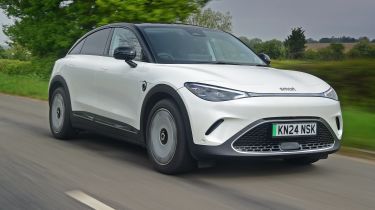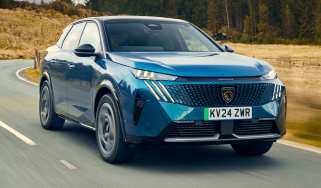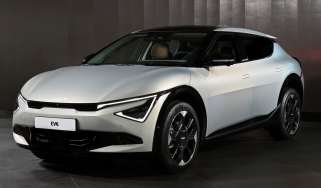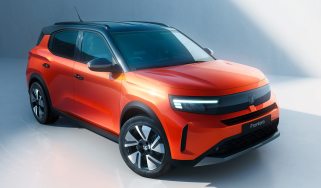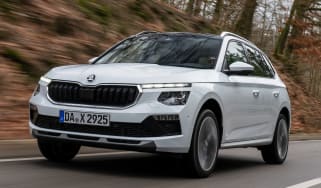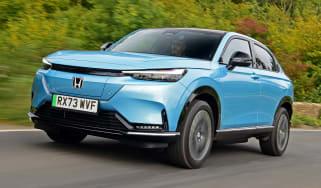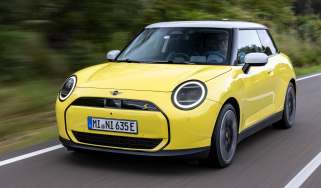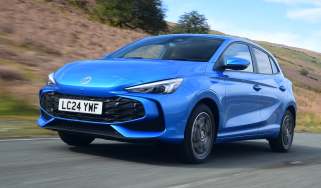Smart #3 review – affordable coupe-SUV with big kit list
“With its own unique style, the Smart #3 cuts a dash amongst EV crossover rivals, and it’s affordable and fully loaded”
Pros
- Individual styling
- Well equipped
- Fun to drive
Cons
- Not that practical
- Laggy infotainment
- Middling range
Verdict – is the Smart #3 a good car?
Smart might be reinventing itself as a manufacturer of electric SUVs, but the Smart #3 still has some of the fun quirks and charm of models like the Fortwo. It’s also much more practical, with a cabin spacious enough for rear passengers and a reasonably sized boot. It feels fun to drive despite not being the quickest electric SUV out there, and yet comfort levels don’t take a hit as a result. While the #3 range figures don’t break any class records, rapid charging means you can get back on the road again in next to no time. Despite its appealing badge and design, the #3 is competitively priced, too.
Smart #3 models, specs and prices
The Smart #3 is an electric SUV coupe that sits just above the recently launched Smart #1 in the brand’s revitalised lineup. It’s the largest Smart yet as the manufacturer moves away from tiny city cars and goes after a larger, more profitable audience of SUV buyers instead.
 Top 10 best electric SUVs 2024
Top 10 best electric SUVs 2024
Priced from just under £33,000, the #3 is a slightly more expensive proposition than the slightly shorter Volvo EX30 it shares some of its technology with. In terms of its size, the Smart #3 is actually the same height as a Volkswagen ID.3 hatchback, despite its SUV styling, and it undercuts the Volkswagen by around £4k.
The #3 costs around £1,500 more than the equivalent Smart #1, which is a slightly narrower and shorter vehicle. The best value is found lower in the range, with the flagship Brabus model hiking up prices to over £45,000. That kind of money isn’t bad for the performance on offer, but we suspect most buyers of mid-size SUVs don’t need to crack 0-62mph in under four seconds very often.
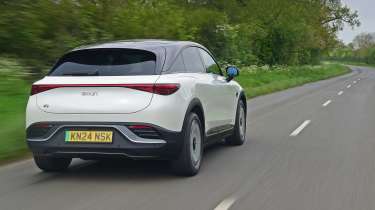
Even the entry-level Pro trim level has plenty of toys, from a sunroof to a bird’s eye view camera for easy parking. Stepping up to Pro+ brings Smart Pilot driver assistance, wireless smartphone charging and leather upholstery. Premium takes things up a notch with tech including a head-up display and improved stereo, while the top Brabus trim gets a sporty makeover and big 20-inch wheels.
Pro comes with a 49kWh battery, while all other trims benefit from a larger 62kWh item for a 283-mile range – slightly further than the Smart #1 thanks to the #3’s sleek bodywork. A single motor powers the rear wheels unless you pick the dual-motor Brabus.
| Trim levels | Power options |
|
|
How we tested the Smart #3
We’ve now driven the Smart #3 on UK roads in May 2024, as well as previously in Mallorca at an international launch in November 2023. We drove it on a mixture of urban and rural roads, as well as the motorway. Our expert road testers have driven every car in the Smart #3 class that's currently on sale in the UK and the opinions in this review are based on how well the car performs compared to those similar rivals. Read more about why you can trust Carbuyer reviews...

Range, charging & running costs
So far we’ve tried out the Smart #3 with the 62kWh battery that’s likely to reach more customers than the 49kWh version, given that it’s standard in most of the mid-range trim levels. With a range of up to 283 miles in the Premium trim car, it should be ample for many owners, and it’s competitive with most rivals – the Kia Niro has a range of 280 miles, while the BYD Atto 3 has an official range of around 260 miles. The Skoda Enyaq can travel up to 354 miles between charges, but it’s a larger SUV than the Smart.
The Smart can replenish its battery rather quickly though, with both the small and large battery options taking around 30 minutes to go from 10 to 80% using a fast enough public charger. They boast peak charging speeds of 130kW and 150kW respectively, and charge a bit more quickly than rivals like the BYD Atto 3 and Honda e:Ny1 as a result.
Like all EV models, the Smart #3 is exempt from VED (road tax) until new rules come into force in 2025. It will also prove much cheaper to run for company car choosers than an equivalent petrol, diesel or hybrid model, thanks to the low Benefit-in-Kind band for zero-emissions models. Other benefits include tariff-free entry in some clean air zones including the ULEZ in London.
| Model | Battery size | Range |
| Smart #3 Pro | 49kWh | 202 miles |
| Smart #3 Pro+ | 62kWh | 283 miles |
| Smart # Brabus | 62kWh | 258 miles |
How efficient is it in the real world?
During our first test drive on Spanish roads in cool winter weather, we managed an efficiency figure of 3.8 miles/kWh during a fairly gentle cruise. Given the size of the battery pack, this would result in a real-word driving range of just under 240 miles. However, we found during our UK drive that its range figure dropped significantly if we really exploited the Smart #3’s performance.
What will it cost to insure?
While insurance groups haven’t been released for the Smart #3 quite yet, it should be similar to the #1, which spans from groups 30 to 37 out of 50. Stick with the Pro trims for the most affordable cover, and avoid the Brabus which jumps up to the higher tier. While these ratings may appear quite high, they are par the course for similar electric coupe SUVs, with the Skoda Enyaq Coupe sitting in groups 27 to 36.
Electric motor, drive & performance
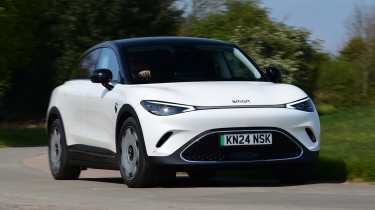
Now that we’ve driven the Smart #3 in the UK, our initial impressions at its launch in Mallorca have been confirmed. We found the #3 to be a lot of fun to drive, and while there are certainly quicker and more responsive EVs out there, we enjoyed prodding the throttle here and there to push the car around bends – it feels eager and you notice the rear wheels putting the power down to help it remain balanced and composed.
It’s not perfect – the steering, while quick, doesn’t offer a lot of feedback – but the Smart is very composed with little body roll. It took us some time to get used to the brakes, which didn’t feel as responsive as we’d expect at first, but there’s a nack to driving it that you soon get into.
As before, we’re less impressed with the regenerative braking system – which gently decelerates the car as kinetic energy is harnessed and fed back into the battery – there’s too much of a delay between letting go of the throttle and slowing down effectively for our liking. We also found that changing the driving modes (Eco, Comfort and Sport) did very little to noticeably alter how the Smart #3 drives.
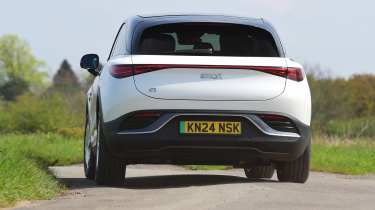
A fun driving experience all too often comes at the expense of comfort, but we found the Smart #3’s ride quality to be mostly very good. The suspension did a surprisingly accomplished job of smoothing out large speed bumps, although over rough roads the suspension can fidget quite a bit. Wind noise levels were very quiet, although one thing we noticed on British roads was quite a bit of tyre noise, which wasn’t such an issue on Spain’s smoother tarmac. All things considered, we think buyers would be able to go for the large 19-inch monobloc-style alloys without it having too much of a negative effect on the ride.
The Brabus version sees another electric motor powering the front wheels, almost doubling its performance. It makes it seriously quick in a straight line, but this abundance of acceleration does seem slightly out of kilter with the rest of the car. The brakes act a bit like a switch, and the steering is similarly lacking in feedback.
Is it good to drive in town?
The Smart isn’t as big as it first appears, only taking up as much space on the road as a family hatchback, so it’s pretty well suited to navigating city streets and car parks. However, we did find the throttle pedal a bit too sensitive in Eco and Comfort modes – in most rivals, these modes reduce the accelerator pedal’s sensitivity to save battery and make town driving easier.
Is it good to drive on long journeys?
While it’s still a bit less comfortable than its smaller sibling or the Skoda Enyaq Coupe, the Smart #3’s ride does improve at higher speeds, and it’s a pretty relaxed motorway or A-road companion, though power does seem to taper off at these higher speeds. The main issue is tyre noise, which becomes fairly prominent at higher speeds.
Is it good to drive on B-roads?
Even with a single 268bhp motor, the rear-wheel drive Smart feels plenty quick enough for a small SUV, and acceleration feels very nippy up to around 60mph, even though rivals feel quicker.
There’s no getting away from the fact the #3 is fairly heavy – in the same ballpark as a big diesel estate car – which explains why the 268bhp on tap might not feel as fast as it sounds. When you do give it some, there’s not much in the way of body lean and the car stays nicely composed.
| Model | Power | 0-62mph | Top speed |
| Smart #3 | 268bhp | 5.8s | 112mph |
| Smart #3 Brabus | 422bhp | 3.7s | 112mph |
Interior & comfort
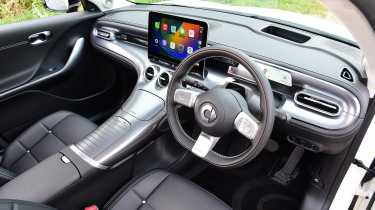
Essentially a coupe version of the Smart #1, the #3 is longer, lower and wider for a more sporting appearance. As such it doesn’t have too many rivals yet. The Skoda Enyaq Coupe and Tesla Model Y are a bit larger and more upmarket while like the Mercedes EQA and BMW iX2 cost a lot more money. Because both Smart and Volvo are now part-owned by manufacturing giant Geely, the #3 is related to the Volvo EX30, but you wouldn’t know from looking at them.
Smart has launched the car with a mixture of subdued and bold colours, so you can stick with white or black, or be really daring and pick bright yellow. Contrasting body and roof colours are a further option to consider. While we commend Smart for offering interesting colour schemes, caution may be required as bright yellow cars are notorious for suffering from excessive depreciation on the conservative British market.
If you’re bored of samey interiors, the Smart could appeal with its unique design flourishes. For a start, you sit quite low and snug behind the wheel, with a very high centre console between the front seats. This is painted to match the dashboard trim, and gets a few cubbies, along with stylish circular air vents in a nod to past Smart models like the Fortwo. We do have some gripes though – many of the interior plastics feel flimsy and cheap, and our UK test car was producing a rattle from the centre console, which we managed to sort by putting the storage lid in the up position.
Is the infotainment and navigation system easy to use?
There’s a large 12.8-inch tablet-style infotainment screen perched above the dashboard, while a 9.2-inch instrument display is rather low down behind the steering wheel. We suspect the latter is to allow the Smart’s driver attention monitoring camera to get a good view of the driver’s face, but it can make the information a bit hard to see.
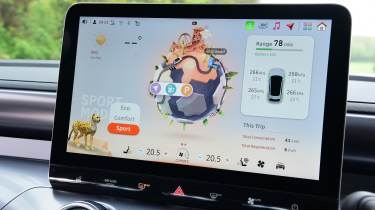
Unfortunately, the infotainment felt very slow to respond, and our test car’s touchscreen actually froze completely a few times while we were on the move. This lag makes it harder to use and bugs will become tiresome if you have to pull off somewhere to stop and reset the car on a longer journey. We found the whole interface difficult to navigate – the main menu was inundated with too many apps and options, so we hope future updates can address some of these gripes.
Which trim level and options should you choose?
Yes, the Smart wins points here, because you aren’t going to feel shortchanged no matter which trim level you pick. Even the entry-level Pro trim gets items like a powered tailgate, sunroof and a bird’s eye view camera (which generates an overhead view of the car and its surroundings on the screen) for easy parking. Upgrading to Pro+ adds leather seats, wireless smartphone charging and Smart Pilot, which is a suite of driving assistance tech that helps to reduce fatigue in heavy stop-and-start traffic.
More tech is included with Premium, including a head-up display, which helps with the problem of the low-mounted instruments, an improved sound system and ambient lighting for an even more contemporary look. It also gets a heat pump, which can improve range in cold weather by warming the cabin more efficiently. A 25th Anniversary Edition is also available with unique colours and red exterior details, while the Brabus sits as the sporty version, with 20-inch wheels, a body kit and suede seats.
While Smart used to be known for offering lots of customisation options – including some rather wacky ones – this doesn’t appear to be the case for the #3. It’s more just a case of picking the trim level with the looks and equipment you want, with the only personalisation being paint colours and some interior trim items.
Key features | |
Pro
|
Pro+
|
| Premium (Pro+ plus…)
|
Brabus
|
Practicality & boot space
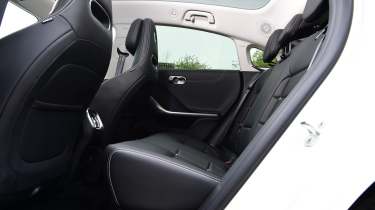
Despite being a coupe-style SUV with a curved roofline, there are still five seats in the Smart #3 and passengers in the back won’t find their heads pressed into the ceiling. Smart’s designers have lowered the seats to help prevent this, and the standard panoramic roof also liberates a bit of extra head space. As a result, we were impressed with the #3’s interior space, especially given our UK car’s optional panoramic roof which made the cabin feel airy and welcoming.
The charging flap is located on the passenger side rear wing, which should suit most public chargers with a bay you can easily reverse into. We suspect this should also be fine for most homeowners with driveways and wallbox chargers, although you may need a fairly long cable if it’s on the opposite side of your driveway or garage.
Size comparison | |||
| Model | Length | Width | Height |
| Smart #3 | 4,440mm | 1,844mm | 1,556mm |
| Volvo EX30 | 4,233mm | 1,836mm | 1,555mm |
| BYD Atto 3 | 4,455mm | 1,875mm | 1,615mm |
| Tesla Model Y | 4,750mm | 1,920mm | 1,624mm |
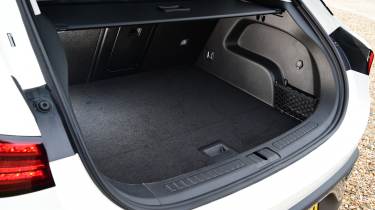
How big is the boot?
It isn't massive. While the extra length of the Smart #3 oddly means its boot is 43 litres bigger than that of the #1, the 370-litre capacity still isn’t much for an SUV, being smaller than you’ll find in a Volkswagen ID.3 hatchback. There technically is a small storage ‘frunk’ under the bonnet, but at just 15 litres it’s of limited use. Still, it could be handy for storing an emergency first aid kit or short charging cable. Thanks to its increased length, the #3 does have a bigger boot than the shorter Volvo EX30.
The Smart’s boot is also slightly more accommodating than the one in the Honda e:Ny1, but if you need a bigger boot altogether, the more upright BYD Atto 3 has more space behind its rear seats. The Skoda Enyaq Coupe is one of the few other electric coupe SUVs on sale, but it's a significantly larger car and offers 570 litres of boot space. The #3 wins back points for having a 60:40 split seat with a ski hatch, so narrow and long items can be loaded with passengers sitting on either side. Unfortunately, though, the sliding rear seat in the #1 is missing here.
Boot space comparison | |
| Model | Boot space |
| Smart #3 | 370 litres |
| Volvo EX30 | 318 litres |
| BYD Atto 3 | 440 litres |
| Tesla Model Y |
854 litres (to roof) |
Reliability & safety
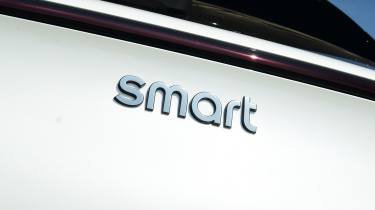
While Smart used to be owned by Mercedes, its latest models have more in common with EVs from Volvo and Polestar. This will make it difficult to judge the Smart #3’s reliability for a few years, but take a look at Polestar instead and it came an impressive second in our Driver Power standings out of 32 manufacturers - ahead of Volvo in 13th place. That’s not bad, however, 69% and 27% of Polestar and Volvo owners respectively reported a fault within the first year, which suggests there could be some teething problems to overcome.
There’s no doubt that the #3 is packed with advanced features, and this also extends to its safety credentials. Technology includes ‘Smart Pilot’, which is an extension of adaptive cruise control that can take care of acceleration, braking and steering in traffic to make the driver’s life easier. Other features are blind-spot monitoring, automatic headlights and self-parking.
We’ve also sampled Smart’s driver attention system, which uses a camera to check the driver is focused on the road ahead. It has been tweaked to be less intrusive than in the #1, but we found that the alert could still be triggered by the driver turning their head at junctions, drinking from a bottle or even putting a hand up to their face. This technology is still some way off working perfectly.
What are the service intervals?
The Smart is somewhat unconventional here, because we expect it to come with the same ‘Integrated Service Package’ as the #1. This includes three years/30,000 miles of maintenance and roadside assistance at authorised dealerships when you buy the car.
What is the warranty?
Smart models come with a three-year warranty, so while it matches the likes of Skoda and Ford, it’s not a great selling point for the brand. Rivals including Hyundai (five years), Kia (seven years) and Toyota (up to 10 years with main dealer servicing) offer longer periods of warranty cover. Extended warranties are offered, but you’ll need to pay extra for the peace of mind.
Is the Smart #3 a good car and should you buy one?
If you like to stand out, find sleek SUVs appealing and are bored of most car interiors that you’ve looked at recently, the Smart #3 could hold strong appeal. Especially in bright colours with a contrasting roof, it doesn’t look like anything else on the road, and its interior design is also quirky. If you find EVs from Mercedes, Volvo and Polestar a bit too straightlaced, Smart feels like the fun relative of the group.
While even the larger 62kWh battery isn’t huge nowadays, its official range figure should suit most drivers who will only need to charge up every week or so – the average daily commute is around 20 miles – and Smart’s SUV offers very quick charging times. Still, there are other cars that can go further on a single charge if that’s something you require often.
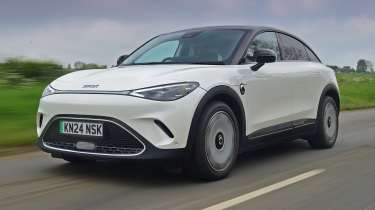
Performance is punchy in the standard version – we actually wish it was slightly more sedate in town – and the Brabus is seriously quick, which can sometimes feel at odds with an otherwise smooth SUV. If you need a sudden burst of power to join a faster road or make an overtake, there are no issues here.
Given the small boot, the Smart #3 wouldn’t be our recommendation for families, but decent passenger room in the back means taking friends or relatives for an occasional spin won’t be an issue.
What is the Carbuyer pick of the range?
For affordability, we’d stick with the Smart #3 Pro+, which costs from just over £35,000. This comes with the larger battery pack, so not only can you go further between charges, we anticipate it will also have better residual values than the Pro. VED (road tax) is free for now, BiK is very cheap for company car drivers and it avoids many tariffs for cars with higher CO2 figures.
The Brabus is something of a spaceship amongst traditional SUVs, with 422bhp and four-wheel drive giving it sports car performance. It isn’t quite as much fun to drive as those numbers suggest, however.
We’d stick with the Pro+ because despite it being the cheapest trim level with the 62kWh battery, it certainly isn’t lacking in kit. Everything from the infotainment setup to the sunroof is included.
Smart #3 alternatives
The Smart #3 is one of a growing number of electric SUVs similar in size to a traditional family hatchback like the Golf or Focus. This means it faces competition from not only electric hatchbacks, but it also sits in the middle ground between small electric SUVs like the Hyundai Kona and Peugeot 2008, and bigger mid-sized SUVs like the Skoda Enyaq Coupe and Tesla Model Y that have more space for a growing family, but are still competitively priced.
Small electric SUVs
Electric crossovers are a hot ticket, with almost every manufacturer having launched one or just about to. It’s hard to beat the value of the Volvo EX30, which is also competitively priced and its chiselled styling will appeal to many SUV buyers. Meanwhile, the Hyundai Kona is the reigning Carbuyer Best Small Family Car.
Mid-size electric SUVs
If you’re looking at a higher trim level of #3, your budget will also stretch to a mid-size SUV. These might not be as quirky as the Smart, but they offer significantly more boot space and passenger room in the back, while the Tesla Model Y also brings access to the excellent Supercharger network of public chargers.
Electric hatchbacks
While it’s billed as an SUV, in reality, the Smart #3 isn’t really much bigger or any more practical than a family hatchback. If you’d rather stick with a more conventional model, the Cupra Born is well-equipped and good to drive, while the MG4 is a stonewall bargain.
